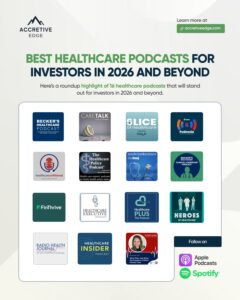A lot of buyer persona templates weren’t designed with healthcare in mind. They tend to focus on surface traits — a name, a title, some generalized goals — and stop there. Think: Linda, 45, hospital administrator, values innovation.
That might work in simpler markets. But in healthcare, the buying process often runs through a system — not a single decision-maker. Clinical, financial, technical, and operational leaders all play a role, each viewing your solution through a different lens. If your persona doesn’t reflect that complexity, it may not hold up once the real evaluation begins.
In this piece, we’ll look at how healthcare personas can be built to match how decisions actually move — helping teams speak to the right priorities, reduce friction, and support deals that make it to the finish line.
The Reality of Healthcare Buying: It’s Not One Persona — It’s a System
A typical buying motion might begin with a clinical lead noticing a gap in care delivery. From there, the process pulls in IT to assess integration, procurement to evaluate compliance and legal risk, finance to run cost modeling, and governance teams to align it with system-wide strategy.
Each function brings a different lens:
- Clinical wants better outcomes and faster workflows
- IT wants fewer endpoints and easier integration
- Finance wants to protect margin and avoid budget surprises
- Procurement wants clean terms and low risk
- End users want something that won’t make their day harder
It’s not unusual to see six to ten stakeholders directly involved in the evaluation. And that’s before counting informal influencers — frontline users, executive assistants, peer references — who might not show up on an org chart but still shape outcomes.
System consolidation has only intensified this. Some hospitals now operate under centralized contracting models. The goalpost is moving: you’re not necessarily selling to one hospital administrator. You might be selling to a region-wide network with a formal procurement hierarchy. Even if one site is ready, the broader system might not be.
And in this kind of environment, personas that reduce everything to a single decision-maker or job title tend to miss what actually drives the deal forward — or sideways.
What Actually Drives Behavior at Each Level
Personas aren’t just profiles. They’re behavior maps under pressure. What that person wants isn’t nearly as important as how they evaluate risk, opportunity, and trade-offs when a new solution is introduced.
Below is a breakdown of five critical personas based on roles they play in the buying process.
1. The Economic Buyer
Typical titles: CEO, COO, CFO, VP of Finance, Procurement Director



| Focus Area | Details |
| Primary Goals | Margin protection, ROI, financial sustainability |
| What Drives Evaluation | Total cost of ownership, return on investment, alignment to budget cycles or strategic cost initiatives |
| Risk Lens | “If this doesn’t work, what’s the financial downside — and who’s accountable?” |
| Common Pain Points | Revenue compression, capex constraints, multi-year commitment hesitation, thin margins |
| What Tends to Work | ROI calculators, business cases with financial projections, peer CFO testimonials, HFMA-aligned metrics |
2. The Clinical Buyer
Typical titles: Chief Medical Officer, Chief Quality Officer, Chief Nursing Officer, VP of Population Health and Care Management, Department Chief, Clinical Champion




| Focus Area | Details |
| Primary Goals | Better clinical outcomes, patient safety, and care quality. Reduce provider burnout, align to value-based care, improve consistency and scale of care programs. |
| What Drives Evaluation | Real-world results, automation potential, impact on workflow, cost savings, peer usage. Ability to address regulatory and reporting demands without burdening staff. |
| Risk Lens | “Will this help our teams deliver care more effectively — or just make their jobs harder?” |
| Common Pain Points | Too much data without actionability. Workflow bottlenecks in EHRs. Manual data entry and reporting fatigue. Staff burnout and shortage. Inconsistent care protocols. Unscalable manual processes. |
| What Tends to Work | Peer-reviewed results, department-level pilots, pragmatic demos showing less manual work, better timing of insights, and smooth integration into workflows. Solutions that reduce friction, not add more. |
3. The Technical Buyer
Typical titles: CIO, CMIO, VP of Applications, CTO, IT Governance Committee




| Focus Area | Details |
| Primary Goals | System stability, IT governance, integration, data security |
| What Drives Evaluation | API specs, EHR compatibility (Epic, Cerner, etc.), scalability, downtime risk |
| Risk Lens | “What does this add to my queue? What breaks if it doesn’t work?” |
| Common Pain Points | Endpoint sprawl, compliance gaps, interoperability failure, shadow IT risk |
| What Tends to Work | Architecture diagrams, SOC 2s, sandbox environments, governance documentation |
4. The Champion / End User
Typical titles: Chief Innovation Officer, Nurse Manager, Care Coordinator, Pharmacy Tech, Call Center Lead
| Focus Area | Details |
| Primary Goals | Simpler workflows, less manual rework, usable tools that reduce daily friction |
| What Drives Evaluation | Whether it saves time, integrates into daily habits, and feels intuitive |
| Risk Lens | “Is this going to make my day easier — or harder?” |
| Common Pain Points | Cumbersome interfaces, lengthy training cycles, no user voice in selection |
| What Tends to Work | Shadowing, demos with real workflows, quickstart guides, peer feedback |
5. The Gatekeeper
Typical titles: Procurement Lead, Legal, Value Analysis Committee

| Focus Area | Details |
| Primary Goals | Vendor vetting, process adherence, legal clarity, risk mitigation |
| What Drives Evaluation | Compliance checklists, ease of contracting, precedent with similar vendors |
| Risk Lens | “Will this become a contract we regret signing?” |
| Common Pain Points | BAA gaps, vague pricing, unclear support or SLAs |
| What Tends to Work | Pre-approved BAA templates, SOC 2 audits, clear ownership terms, rapid legal review pathways |
Taken individually, each persona tells you something about how your solution is perceived. Taken together, they form the reality of how healthcare decisions actually move — or stall.
The mistake isn’t in building the wrong persona. It’s in building just one.
Best Practices That Drive Sales Outcomes
Once you step away from static, one-dimensional persona templates, you open up a more useful lens: how each stakeholder actually processes risk, evaluates solutions, and influences others in the room. The point isn’t to humanize the buyer — it’s to anticipate their behavior when a new solution enters the conversation.
Here’s what we’re seeing work among commercial teams selling into U.S. health systems:
1. Build from the buying process back — not the profile forward
Instead of starting with demographics or traits, start with how the deal moves through the system.
- Who triggers the conversation?
- Who gets pulled in during evaluation?
- Who owns final sign-off?
- Where are the points of resistance?
From there, build profiles that reflect real influence and timing, not just titles.
2. Use internal intelligence — not just outside research
Some of the best persona insights don’t come from marketing surveys. They come from:
- Win/loss notes
- Sales call recordings
- Enablement debriefs
- Customer success handoffs
The language stakeholders use when pushing back is usually more telling than what’s in a pitch deck. A clinical director saying, “It sounds interesting, but we’re already overloaded with tools that don’t talk to each other,” tells you more than any LinkedIn bio.
3. Layer messaging to match decision sequencing
Not everyone needs the same pitch — and not at the same time.
- For the clinical buyer, lead with evidence and workflow impact.
- For the technical buyer, queue up integration and governance docs early.
- For the economic buyer, don’t just send “pricing” — send ROI logic with budget timing in mind.
This isn’t about personalization at scale. It’s about message sequencing that reflects how decisions actually move inside a system.
4. Anchor to perceived risk — not just stated value
Here’s where a lot of solution messaging gets stuck: it leads with what you think is valuable. But the buyer is filtering it through what they’re afraid of.
- What you see as automation, they see as less control.
- What you see as innovation, they see as more endpoints to secure.
- What you see as outcomes, they see as non-reimbursable work.
If your persona doesn’t account for that mental model, the positioning won’t hold.
5. Treat personas as revenue tools — not brand exercises
Ultimately, this is about deal velocity and sales enablement — not persona PDFs that sit in folders. The goal is to give your team practical tools to say:
- “From where the CMIO sits, here’s how we’ll need to frame integration.”
- “This won’t land with the CFO unless we translate it to margin impact.”
- “Procurement is going to need language around post-sale support, or this stalls before contracting.”
That’s what makes persona work useful — and durable.
Final Thought: Evolving the Healthcare Persona Map
Healthcare personas aren’t a one-time exercise. They’re a moving target — shaped by shifting roles, new governance layers, and changes in how health systems evaluate risk. What worked last quarter might miss the mark today. The teams seeing traction are treating personas as live inputs to their GTM strategy, not marketing assets.
If your healthcare messaging isn’t landing, your personas may not be wrong — they just may be misaligned with how buying is actually happening now.
If you’re rethinking how to position your solution across clinical, economic, and operational stakeholders, we’d be glad to pressure test the map with you. It’s one of the most valuable hours you can spend before your next system meeting.






